Transform Your Closet: Tips for Style and Organization
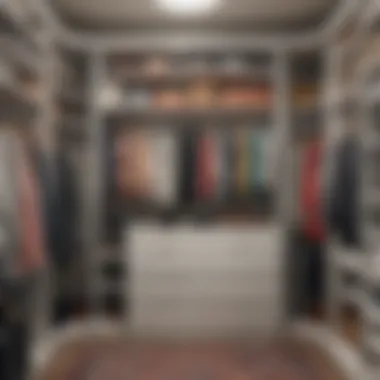
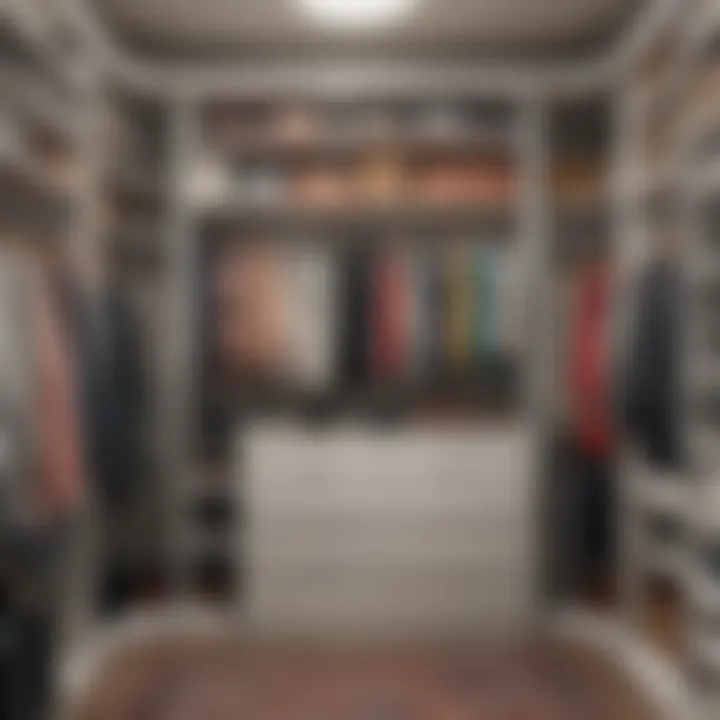
Intro
The appearance and functionality of a closet can subtly influence day-to-day activities. A well-organized closet not only enhances efficiency but also elevates the overall aesthetic of a space. This article will detail various strategies for making a closet not just functional but also visually appealing. By employing practical design principles, smart storage solutions, and effective styling techniques, one can create a sanctuary that reflects personal taste while fostering ease of access.
Understanding how to curate your closet space is essential, especially for homeowners, interior design enthusiasts, and those who host social gatherings. The aim here is to not merely organize but to transform a closet into a cohesive aspect of home design.
Design Inspiration
Current Trends in Interior Design
The evolution of interior design trends continuously informs how closets can be styled. In recent years, open shelving has gained prominence; it blends functionality with design, allowing for both display and storage. This approach encourages homeowners to curate their wardrobe thoughtfully. Incorporating elements like natural wood finishes and metal accents can also lend a contemporary touch.
Minimalism remains a steadfast trend. Hiding items behind doors can create a clean visual line. Decluttering is key to this style, so consider evaluating what you truly use and love before refining your closet.
Color Schemes and Palette Ideas
Choosing a color palette matters significantly. Neutral tones like beige, cream, or soft grey can create a serene environment. These hues also make spaces seem larger and more organized. Alternatively, a bold accent color, perhaps in the form of paint or accessories, can invigorate the space without overwhelming it. Some examples include deep navy or emerald green for shelves or boxes.
When selecting colors, consider the overall design of your home. Cohesiveness strengthens the aesthetic flow, ensuring that each element feels integrated. The right color scheme will contribute to a calming atmosphere, enhancing the experience of using the closet.
Practical Organization Tips
Creating an efficient closet requires a strategic approach. Here are several straightforward methods to improve organization:
- Assess and Purge: Regularly review items in your closet. Donate or recycle what you no longer need.
- Categorize Items: Organize clothing and accessories into categories. Group similar items, like winter wear and summer clothes, for better accessibility.
- Use Uniform Hangers: Opt for the same type of hanger to create a streamlined look. This small adjustment can enhance the visual consistency of your closet.
- Implement Storage Solutions: Use bins, boxes, or drawer dividers to separate smaller items. Labeling these can help maintain order.
The effectiveness of these organization techniques can significantly streamline daily routines, making the closet a more inviting space.
Styling Techniques
Finally, the aesthetic appeal can be heightened through thoughtful styling techniques. Consider incorporating decorative elements while maintaining functionality:
- Display Statement Accessories: Use shelves to display hats, bags, or shoes that can serve as decorative elements.
- Integrate Lighting: Install soft lighting that highlights your curated items or illuminates dark spaces.
- Add Personal Touches: Consider artwork, photos, or personal mementos to make the closet feel more welcoming.
"A closet, like any part of your home, should reflect who you are and be a space you enjoy accessing."
By thoughtfully considering design, organization, and styling, it is possible to transform an ordinary closet into a visually appealing and personal space. Expect to find joy in each time you open those doors.
Understanding the Importance of Closet Aesthetics
Closet aesthetics transcends mere visual appeal; it plays a crucial role in enhancing daily life. A well-organized and inviting closet can streamline morning routines, reduce stress, and foster a sense of control. Proper organization enables quick access to items, allowing individuals to navigate their days efficiently.
In addition to improving functionality, the appearance of a closet reflects one’s personal style. It serves as a visual representation of individual tastes, offering insight into one’s identity. Whether one leans towards minimalism or embraces vibrant patterns, the choices made within closet space convey personal values and preferences. This aspect of aesthetics stimulates creativity and serves as a canvas for personal expression.
Therefore, understanding the importance of closet aesthetics is pivotal for homeowners and design enthusiasts alike. Not only does it impact the functionality of the space but it also influences how individuals interact with their belongings. Selecting cohesive storage solutions and thoughtful design elements can transform cluttered corners into inspiring environments. It is the harmony of function and style that makes a closet both practical and appealing.
"A beautiful and organized closet is not just a luxury, but a tool for daily happiness."
Influence on Daily Routines
The impact of closet aesthetics on daily routines cannot be understated. A beautifully arranged closet makes it easier to find and select clothing or accessories in the mornings. When items are organized thoughtfully, decision-making becomes simpler. This can lead to a smoother start to the day, allowing more focus on tasks beyond wardrobe choices.
In contrast, a chaotic and poorly organized space can contribute to wasted time and frustration. Searching for an often-worn shirt in a jumble can result in stress, leading to a rushed, unprepared morning. Individuals may pull random items from shelves, only to realize later that they do not match or are inappropriate for the occasion. Therefore, closet organization directly correlates with efficiency and peace of mind in one’s daily life.
Reflection of Personal Style
The closet is not just a storage area; it is a canvas that reflects personal style. Each item within serves as a representation of who an individual is or aspires to be. From classic, tailored pieces to trendy accessories, every choice is a statement. A closet that showcases these items aesthetically fosters a sense of pride and ownership of one's style.
By arranging clothing in a visually appealing manner, individuals can curate a space that inspires them. This encourages them to wear items they love more often, leading to increased confidence. An aesthetically pleasing closet also invites creativity. It allows individuals to play with outfit combinations, which can be both fun and rewarding.
To summarize, recognizing the importance of closet aesthetics helps individuals appreciate their belongings and boosts their self-image. Your closet is an extension of yourself; take the time to make it inviting and reflective of your personal style.


Initial Assessment of Your Closet Space
The initial assessment of your closet space serves as a critical foundation for transforming it into a visually appealing and organized area. It allows you to identify strengths and weaknesses in your current setup, which informs the approach you will take in improving the aesthetics as well as functionality. Neglecting this step can lead to wasted time and effort later, so it is vital to approach it with a keen eye.
Evaluating Current Organization
Begin by taking a thorough look at how your closet is currently organized. Ask yourself whether everything is easily accessible or if you often find yourself searching for items. Consider the following elements:
- Clutter Level: Identify areas where items are stacked or crammed together. Clutter often hinders both visibility and accessibility.
- Categorization: Examine whether similar items are grouped together. Consistent categorization can improve not just the look of your closet but also its usability.
- Ease of Access: Evaluate how readily you can reach items located in the back or at the top of shelves. A well-organized closet should let you find what you need without unnecessary digging.
Understanding your current organization will guide the decisions you make about what storage solutions and aesthetic choices to implement as you move forward.
Identifying Space Constraints
Knowing the limitations of your closet space is equally important. Each closet is unique and comes with its own set of constraints, making it essential to recognize these before launching into a makeover. Key elements to consider include:
- Dimensions: Measure your closet’s height, width, and depth. This will help you select appropriate shelving, storage boxes, or hanging systems that fit.
- Layout: Consider the configuration of your closet. Is it a walk-in, reach-in, or a simple wardrobe? The layout greatly affects which organization methods will work best.
- Natural Light Sources: Identify where light sources are located. A closet that lacks natural light may require additional artificial lighting to enhance its overall appeal.
By identifying these constraints, you can make informed decisions that lead to a more functional and appealing closet space. This assessment not only lays the groundwork for a more organized environment but also contributes to a space that resonates with your personal style.
"A well-assessed closet space is the first step towards a functional and visually appealing storage solution."
This phase sets the stage for subsequent steps, which could involve decluttering, selecting storage options, and arranging your items with care. Understanding what you have and the space you are working with will ultimately enhance your experience and satisfaction with your closet.
Decluttering: The First Step to Improvement
Decluttering is an essential process when enhancing your closet's appearance and functionality. It serves as a foundation for everything that follows. By eliminating items that no longer serve a purpose, you create a blank canvas. This allows for better organization and the opportunity to make strategic storage decisions. A decluttered closet is visually appealing and simplifies your daily routines. You can quickly locate what you need, which reduces frustration.
Moreover, decluttering has psychological benefits. A cluttered environment can lead to stress and overwhelm. In contrast, a tidy space promotes a sense of calm and control. When you take the time to declutter, you not only improve the look of your closet but also contribute positively to your mental well-being.
Strategies for Effective Decluttering
To begin decluttering effectively, consider the following strategies:
- Set Clear Goals: Define what you want to achieve with your closet. It could be more space, better organization, or aesthetic appeal.
- Create Zones: Divide your closet into sections. This helps to manage your space better. Allocate areas for different categories like clothing, shoes, and accessories.
- Use the Four-Box Method: Label four boxes as keep, discard, donate, and relocate. This simplifies the decision-making process. Every item should be evaluated and placed in the appropriate box.
- One In, One Out Rule: Every time you acquire a new item, consider letting go of an existing one. This prevents future clutter and encourages mindful shopping.
By implementing these strategies, you can streamline the decluttering process efficiently.
Deciding What to Keep or Discard
Determining whether to keep or discard items requires careful consideration. A practical approach includes these steps:
- Assess the Utility: Ask yourself, when did you last use this item? If it’s been over a year, it may be time to let go.
- Evaluate Sentimental Value: It’s natural to hold onto items with sentimental value. However, only keep those that truly bring joy or have significant meaning.
- Check the Condition: Items that are damaged or worn out should be discarded or repaired before being kept.
- Consider Trends and Styles: If your clothing style has shifted, keeping items that do not reflect your current aesthetic may clutter your closet unnecessarily.
Making clear decisions on what to keep or discard can lead to a more manageable and visually appealing closet space.
Optimal Storage Solutions
When it comes to enhancing the aesthetics and functionality of your closet, optimal storage solutions play a crucial role. They not only help maximize the available space but also maintain a neat and organized look. This section discusses various elements regarding storage solutions that will help you create a closet the is both appealing and practical.
Choosing the Right Shelving
Selecting appropriate shelving is vital. It determines how well your items are displayed and organized. The right shelves can elevate the visual appeal of your closet, making it feel spacious and orderly. Consider different types of materials like wood, metal or wire. Each type lends its own aesthetic.
- Wooden shelves often provide warmth and elegance, creating a classic look. They can support varying weights and can be stained or painted to match the overall design.
- Metal shelves offer a modern touch and can handle heavier items. They are typically more durable and support bins for smaller items.
- Wire shelves increase airflow, preventing mustiness and are easier to maintain. They also allow visibility of items stored.
A crucial factor when determining shelf height is access. Items needed frequently should be positioned mid-level, while seldom-used items can be higher or lower.
Utilizing Vertical Space
Closets often have underutilized vertical space that can significantly enhance storage capabilities. Emphasizing vertical space not only increases storage but adds to the visual dynamics of your closet. Here are some techniques to consider:
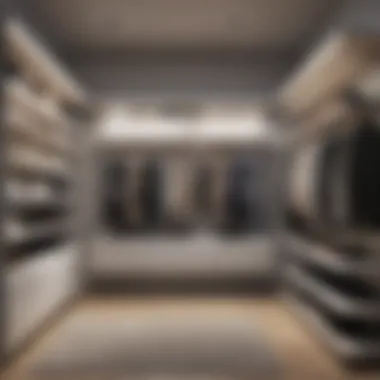
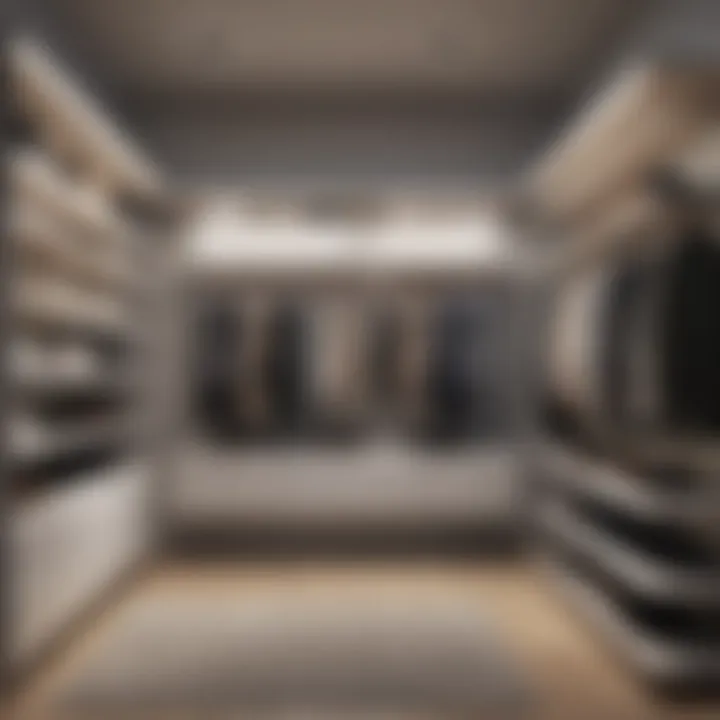
- Tall shelving units allow for extra items without cluttering the floor space.
- Hanging organizers can be attached to the door interior or tall walls. They are effective for shoes, accessories or small garments.
- Hooks and rods can be incorporated for hanging belts, bags, or scarves, keeping them accessible without occupying shelf space.
This effective use of vertical space creates an illusion of a larger area while ensuring everything has a designated spot.
Incorporating Decorative Baskets and Boxes
Adding decorative baskets and boxes can enhance both style and functionality. These elements bring organization combined with visual appeal. Opt for materials and colors that align with your desired aesthetic. For instance:
- Woven baskets add texture and a natural feel. They work well for storing seasonal items or accessories.
- Lidded boxes keep things out of sight but within reach. They are savvy choices for smaller items that may contribute to clutter.
- Clear boxes are practical for visibility, allowing easy access to items without searching through. They work particularly for shoes or folded garments.
Utilizing these storage solutions not only organizes but also elevates the design of closet.
Optimal storage solutions mark the intersection of functionality and aesthetics, making your closet a space that reflects both style and practicality.
Color Coordination and Visual Appeal
Color coordination is a vital aspect of closet aesthetics. Properly arranged colors can transform a cluttered space into an inviting and organized environment. This process does not only involve choosing pleasing colors but also understanding how they interact with light and space. A well-coordinated closet can enhance your daily experience, making selection easier and more pleasant.
Developing a Color Scheme
When beginning to develop a color scheme for your closet, consider the mood and style you wish to convey. Here are several steps to guide your selection:
- Assess Existing Colors: Look at the items currently in your closet. Identify the dominant colors for clothes, accessories, and storage. This will give you a base palette.
- Choose a Dominant Color: Select one color to act as the focal point. This color can tie together various elements within the closet.
- Pick Complementary Colors: Choose two or three additional colors that complement the dominant color. These should harmonize without overwhelming.
- Consider Neutrals: Incorporate neutral tones, like whites, grays, or beiges, to balance the vibrancy of your chosen palette. They can also serve as backgrounds, enabling other colors to stand out.
By carefully selecting colors, your closet can reflect your personality while remaining functional.
Arranging by Color: Techniques and Benefits
Arranging items by color offers several advantages including ease of access and visual pleasure. Here’s why this method is effective:
- Visual Appeal: A color-coordinated closet can be aesthetically appealing, turning a mundane space into a visual delight.
- Simplified Selection: With garments grouped by color, choosing outfits becomes a quicker process. This can be particularly beneficial during busy mornings.
- Space Management: By grouping similar colors, you can often fit more items into a limited space by ensuring the use of shelves and hangers is maximized.
To implement this technique, consider the following:
- Group Similar Shades: Start with the color group you have the most of and work down through the spectrum.
- Use Dividers: If you have various shades of similar colors, use dividers or tags to keep them organized and easy to reach.
- Maintain Consistency: Ensure all items are arranged in the same way—whether by hue or saturation—to avoid confusion.
A well-organized and color-coordinated closet can significantly enhance your overall mood while optimizing efficiency and function.
By focusing on color coordination, you not only enhance the visual appeal of your closet but also improve functionality, reflecting a personal style that resonates with daily life.
Lighting Considerations
Lighting in a closet is often overlooked but plays a pivotal role in how the space is perceived and used. Effective lighting can highlight the organization, colors, and overall design within your closet. Without proper lighting, even the most meticulously arranged closet can appear chaotic. Additionally, the right lights can make it easier to find items quickly, thus enhancing functionality.
Importance of Lighting in Closets
When it comes to design, lighting is not a mere afterthought. Good lighting can enhance visibility, making it simpler to see clothes, shoes, and accessories. It can also influence the ambiance of the closet. If your closet is too dim, it may lead to frustration when searching for items.
Furthermore, lighting works to create a cozy, inviting atmosphere. A well-lit closet can evoke a sense of calm, making it a more pleasant experience when choosing outfits.
"Good lighting not only clarifies what's inside your closet but also elevates the overall design experience."
Types of Lighting: Best Practices
There are various types of lighting options to consider when designing your closet. Here are some best practices to keep in mind when selecting the right lighting for your space:
- Ambient Lighting: This provides general illumination suitable for the entire closet. Recessed lighting or ceiling fixtures can serve this purpose well. Aim for a soft, diffused light to avoid harsh shadows.
- Task Lighting: Focused lighting is crucial in areas where specific tasks occur, like a shoe rack or a jewelry drawer. LED strip lights or spotlights can effectively illuminate these areas.
- Accent Lighting: This type of lighting enhances the aesthetic appeal of your closet. You can use decorative fixtures or even lights integrated into shelves to highlight your wardrobe or accessories.
- Smart Lighting Solutions: Consider installing smart LED lights that can be adjusted through a smartphone app. This flexibility allows you to change the brightness or color temperature based on your mood or the time of day.
Choosing the right lighting can transform an average closet into a well-organized and appealing space. When planning your closet lighting, assess not only where shadows fall but also how the lights work together to create a harmonious environment.
Personalization: Adding Character to Your Closet
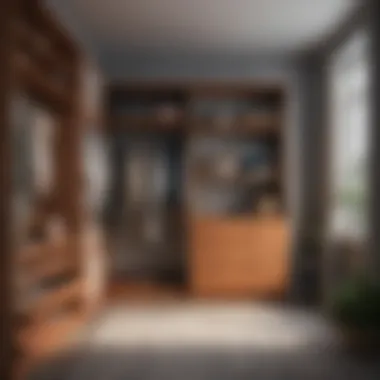
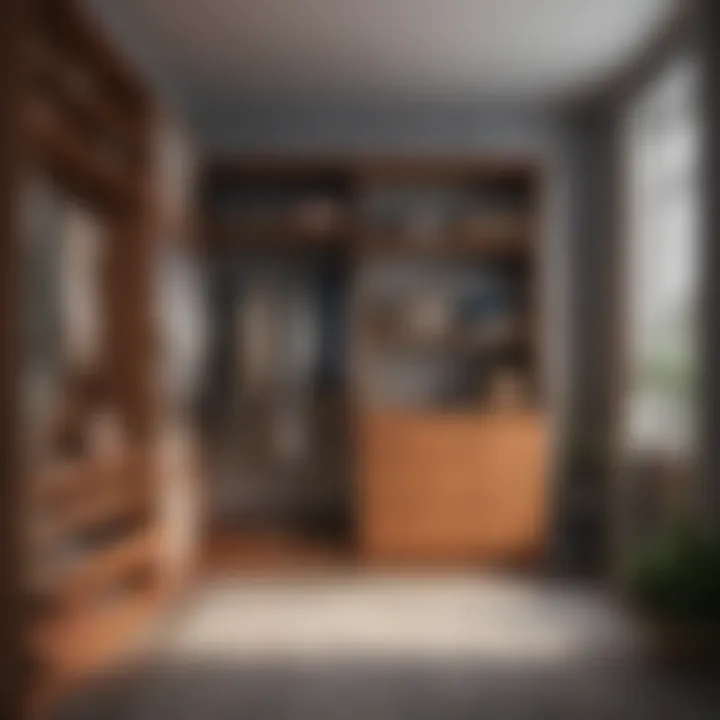
Personalizing your closet is an essential aspect of transforming it into a space that not only reflects your style but also enhances your everyday experience. A well-personalized closet does not just organize your items; it represents a part of who you are. Adding character to your closet can increase your satisfaction with the space and make it more enjoyable to use.
When it comes to personalization, consider what makes you unique. This self-expression can take shape through the arrangement of clothes, the addition of favorite items, or even the colors and types of storage solutions selected. By incorporating personal touches, you can create a closet that feels inviting and aligned to your identity. Benefits of personalization include feeling more inspired each day and enjoying the process of getting dressed. A space that resonates with you fosters a positive mindset, which is especially valuable during busy mornings.
Incorporating Personal Items
Personal items in your closet can range from keepsakes to favorite clothing pieces. Start by choosing items that hold significant meaning to you. These could be gifts from loved ones, heirlooms, or items representing memorable experiences. Display these items thoughtfully; for example, hang a special scarf on a hook or place framed photos on top of a shelf.
Additionally, consider showcasing your favorite accessories. Here are some tips to incorporate personal items:
- Create a dedicated display area: Use a shelf or a ledge to arrange items like jewelry, hats, or bags. This creates visual interest.
- Use themed organizers: Select storage boxes or baskets that reflect your personal style. For instance, if you love travel, a vintage suitcase could double as both storage and decor.
- Rotate displays seasonally: Change out displayed items to keep the closet fresh and interesting.
Artistic Touches without Clutter
Artistic touches can elevate your closet without contributing to clutter. The goal is to enhance the space with decor that is both functional and aesthetically pleasing. Here are some strategies:
- Choose artful storage solutions: Select bins or baskets that are visually appealing. Consider materials like woven rattan or patterned fabrics.
- Incorporate plants: A small potted plant can bring life into your closet. Opt for low maintenance plants like succulents.
- Use wall space creatively: Hang a statement art piece or a mirror. This can make the space feel larger and more personal.
But remember, it is crucial to keep balance in mind. The key to avoiding clutter is to limit the number of artistic touches included. Aim for a few select pieces that truly resonate with you. Too many elements can overwhelm the space.
"Personalization allows you to create a space that energizes you and speaks to your individuality."
Overall, personalization in your closet can transform it from a mere storage space to a vibrant reflection of yourself. By mixing personal items with artful additions, you cultivate an area that not only serves its purpose but also enhances your daily life.
Maintenance Practices for Longevity
The longevity of a well-organized and aesthetically pleasing closet relies heavily on consistent maintenance practices. Without these efforts, even the most beautifully arranged space can quickly become chaotic. Establishing a maintenance routine ensures that the system you have put in place remains effective and continues to serve its purpose. The benefits of regular upkeep are manifold. An organized closet saves time, reduces stress, and allows you to fully enjoy your space. It also protects your investments in clothing and accessories by preventing damage from disorganization and neglect.
Establishing a Routine
Creating a routine is essential for maintaining not just the physical organization of your closet, but also its visual appeal. Start by setting aside time weekly or bi-weekly to assess your closet's condition. During this check-in, focus on the following aspects:
- Clutter Control: Regularly identify items that no longer serve you. Quickly developing the habit of sorting through your belongings prevents over-accumulation.
- Cleaning: Dust shelves and wipe down surfaces to keep the space visually appealing. A clean closet can uplift the overall mood of the room.
- Rearranging: As your wardrobe evolves, so should your organization system. Rearranging items by season or type can keep the closet dynamic and relevant.
Start with a small consistent task. For example, each time you wear something from your closet, think about whether it still fits, whether you like it, and how often you truly wear it. This simple question can guide your decisions during the maintenance process.
Seasonal Reviews and Updates
Seasonal reviews provide an excellent opportunity to reassess your closet. Each time a new season approaches, conduct a thorough examination of what you have. A typical review might include:
- Rotating Seasonal Wear: Store away out-of-season clothes in a way that does not obstruct access to current items. For example, place winter coats in garment bags and store them on higher shelves.
- Cross-Checking Trends: It's prudent to evaluate whether certain pieces are still in style. Clothing that has not been worn the last season often falls into the discard category, especially if it has lost its appeal.
- Implementing New Storage Ideas: With each seasonal change, consider if your storage solutions still work for your current needs. Adding new baskets or updating hangers could enhance storage and appearance.
By committing to these maintenance practices and integrating them into your life, you ensure that your closet is always functioning at its best, reflecting your personal style while remaining practical.
Final Thoughts on Closet Design
In contemplating closet design, it becomes evident that combining elegance and practicality is paramount. The efficient use of space affects not only the aesthetic appeal but also the functionality of the closet. A well-organized closet does not only look good but also enhances the daily routines. This is where the balance of functionality and aesthetics comes into play.
Balancing Functionality and Aesthetics
Closet organization must go beyond mere appearance. Functionality serves as the foundation upon which all designs should rest. Consider your needs first: how many garments you own, the types of accessories, and the frequency of use. Once you identify these, you can then start designing a space that meets these practical requirements.
To strike this balance effectively, one might implement:
- Smart storage solutions: Utilize shelves, drawers, and hanging areas efficiently. Folded items should go on shelves, while others can hang stylishly from rods.
- Streamlined designs: Simple lines and cohesive colors contribute to a spacious feel. Avoid over-cluttering to enhance both function and look.
- Quality materials: Choosing durable products ensures longevity. It also conveys a sense of refinement that complements the overall design.
In the end, it’s not just about making your closet pretty. It’s about creating an environment where you can easily find what you need while also enjoying the visual aspects of the space.
The Long-Term Impact of an Organized Closet
An organized closet offers various long-term benefits that go unnoticed initially. For many, a closet serves as a microcosm of their lives: how they approach organization in one area often reflects their habits in others. Thus, investing time and effort in organizing a closet leads to wider psychological and practical advantages.
Key benefits of an organized closet include:
- Reduced stress: When everything is in its place, the time spent searching diminishes significantly. You can retrieve items with ease, which bags a mental clarity.
- Increased space: A well-organized closet typically uses space more efficiently. This can encourage the sale or donation of items no longer needed, freeing physical and mental clutter.
- Enhanced style: A neat and aesthetically pleasing closet reinforces your personal brand, especially if guests occasionally come across your space.
"An organized closet is more than a visually appealing space; it is a testament to one’s attention to detail and commitment to a structured lifestyle."



